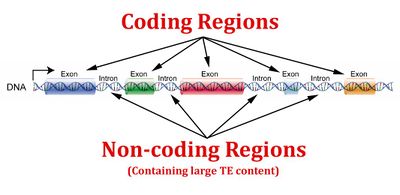Non-coding DNA
Non-coding DNA (ncDNA) sequences are components of an organism's DNA that do not encode protein sequences.
Only about 1% of DNA is made up of protein-coding genes; the other 99% is noncoding.
Noncoding DNA does not provide instructions for making proteins.
Scientists once thought noncoding DNA was “junk” with no known purpose. However, it is becoming clear that at least some of it is integral to the function of cells, particularly the control of gene activity. For example, noncoding DNA contains sequences that act as regulatory elements, determining when and where genes are turned on and off. Such elements provide sites for specialized proteins (called transcription factors) to attach (bind) and either activate or repress the process by which the information from genes is turned into proteins (transcription).
Types of regulatory elements in Noncoding DNA
Promoters: Provide binding sites for the protein machinery that carries out transcription. Promoters are typically found just ahead of the gene on the DNA strand.
Enhancers: Provide binding sites for proteins that help activate transcription. Enhancers can be found on the DNA strand before or after the gene they control, sometimes far away.
Silencers: Provide binding sites for proteins that repress transcription. Like enhancers, silencers can be found before or after the gene they control and can be some distance away on the DNA strand.
Insulators: Provide binding sites for proteins that control transcription in a number of ways. Some prevent enhancers from aiding in transcription (enhancer-blocker insulators). Others prevent structural changes in the DNA that repress gene activity (barrier insulators). Some insulators can function as both an enhancer blocker and a barrier.
The human genome contains thousands of noncoding RNAs (ncRNAs), which are thought to lack open reading frames (ORFs) and cannot be translated.
Some non-coding DNA is transcribed into functional non-coding RNA molecules (e.g. transfer RNA, microRNA, piRNA, ribosomal RNA, and regulatory RNAs).
DNA is double-stranded, but only one strand serves as a template for transcription at any given time. This template strand is called the noncoding strand. The nontemplate strand is referred to as the coding strand because its sequence will be the same as that of the new RNA molecule.
